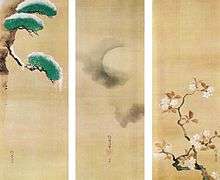Snow, Moon and Flowers
Snow, Moon and Flowers (雪月花, setsu-getsu-ka or setsu gekka) is a Japanese expression and theme in art and design originating from a poem by Tang dynasty poet Bai Juyi[1]. It became popular in the late Edo period. It is a metonym for beautiful sceneries in the nature in Japanese.
Introduction
This threefold theme usually refers to the seasons of the year:[2] snow refers to winter, moon refers to autumn and flowers refers to spring. But one could also think it as representations of three whites: blue-white refers to winter, yellow-white refers to autumn and pink-white refers to spring.
Ukiyo-e artists liked to sell prints in series, sometimes even scrolls were painted to be hanged together. Artists liked to combine it with three women, three well known landscapes (moon always with reflecting water) etc.
"Snow, Moon and flowers" appear also as decoration on boxes, backside of traditional mirrors etc.
| Katsukawa Shunshō (1726–1793) | Sakai Hōitsu (1761–1828) |
|---|---|
 |
 |
| from left to right: --- Sei Shōnagon (winter) ------- Murasaki Shikibu (autumn) ------------ Ono no Komachi (spring) |
Snow Moon Flowers |
- Prints by Shiba Kōkan, signed as Suzuki Harushige (1747–1818)
 Winter at Yoshiwara
Winter at Yoshiwara Moon above Shinagawa
Moon above Shinagawa Spring (yet missing)
Spring (yet missing)
- Prints by Hokusai Katsushika (1760–1849)
 Snow at Sumidagawa
Snow at Sumidagawa
(at Edo) Moon above Yodogawa
Moon above Yodogawa
(in Kansai) Flowers at Yoshino
Flowers at Yoshino
(in Nara Pref.) Snow, Moon and flowers at Tōto (around Edo)
Snow, Moon and flowers at Tōto (around Edo) Snow, Moon and flowers at Yamashiro (around Kyōto)
Snow, Moon and flowers at Yamashiro (around Kyōto) Snow, Moon and flowers at Settsu (around Ōsaka)
Snow, Moon and flowers at Settsu (around Ōsaka)
- Prints by Utagawa Kunisada (1786–1865)
 Snow, Moon and flowers as Sugoroku game
Snow, Moon and flowers as Sugoroku game
- Prints by Utagawa Kuniyoshi (1797–1861)
 Snow in the morning
Snow in the morning Moon (yet missing)
Moon (yet missing) Flowers (yet missing)
Flowers (yet missing)
- Prints by Utagawa Hiroshige (1797–1858)
 Snow at the Kiso road
Snow at the Kiso road Moon above Kanazawa (Kanagawa Pref.)
Moon above Kanazawa (Kanagawa Pref.) Flowers[3] at Naruto
Flowers[3] at Naruto Meisho Snow (Inokashira))
Meisho Snow (Inokashira)) Moon (yet missing)
Moon (yet missing) Meisho Flowers (Koganei)
Meisho Flowers (Koganei)
In popular culture
Literature
- Nippon Daihyakka Zensho - Encyclopedia Nipponica 2001 (E-Book version). Shogakukan, Tokyo 1996.
- In the Unbreakable Machine-Doll light novel, the Setsugetsuka Trilogy is composed of three female automaton sisters; Irori, the eldest sister, representing the snow, Yaya, the second eldest sister, representing the moon, and Komurasaki, the youngest sister, representing the flower.
Comics
- In the Unbreakable Machine-Doll manga, the Setsugetsuka Trilogy is composed of three female automaton sisters; Irori, the eldest sister, representing the snow, Yaya, the second eldest sister, representing the moon, and Komurasaki, the youngest sister, representing the flower.
Video games
- The Japanese title of Fire Emblem: Three Houses is in reference to the theme, as the player spends a full year teaching at the Officer's Academy.
Radio, animation, and television
- In the Unbreakable Machine-Doll anime, the Setsugetsuka Trilogy is composed of three female automaton sisters; Irori, the eldest sister, representing the snow, Yaya, the second eldest sister, representing the moon, and Komurasaki, the youngest sister, representing the flower.
Notes
- 雪月花時最憶君: At the time of snow, moon and flowers, I think of you.
- The short hot summer is skipped.
- Hiroshige uses whirlpools to imitate flowers